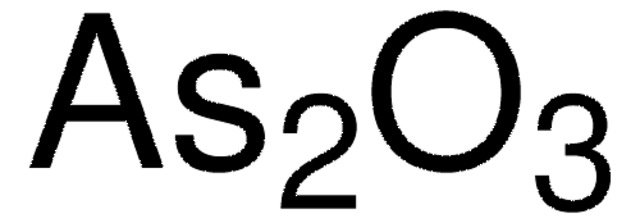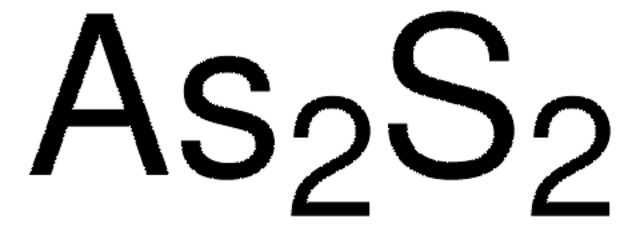202673
Arsenic(III) oxide
99.995% trace metals basis
Synonyme(s) :
ATO, Diarsenic trioxide;, Arsenic trioxide, Arsenous acid
About This Item
Produits recommandés
Pureté
99.995% trace metals basis
Forme
powder
Pertinence de la réaction
core: arsenic
reagent type: catalyst
Chaîne SMILES
O=[As]O[As]=O
InChI
1S/As2O3/c3-1-5-2-4
Clé InChI
IKWTVSLWAPBBKU-UHFFFAOYSA-N
Vous recherchez des produits similaires ? Visite Guide de comparaison des produits
Catégories apparentées
Description générale
Application
- Electrochemical detection applications: A study on La-based perovskites incorporated with functionalized carbon nanofibers highlights the use of arsenic trioxide for the electrochemical detection of roxarsone in water and food samples, providing a method to improve safety and environmental monitoring (John Felix MA et al., 2024).
- Antiproliferative effects in cancer research: Research demonstrates the inhibitory effects of arsenic trioxide, combined with metformin, on KG1a cell proliferation, suggesting its potential utility in developing antineoplastic strategies (Huang-Li WH et al., 2024).
- Environmental remediation: A review on manganese oxide-based materials for arsenic removal discusses the application of arsenic trioxide in environmental remediation, focusing on the effectiveness and advancements in arsenic decontamination technologies (Younas M et al., 2024).
Mention d'avertissement
Danger
Mentions de danger
Classification des risques
Acute Tox. 2 Oral - Aquatic Acute 1 - Aquatic Chronic 1 - Carc. 1A - Eye Dam. 1 - Skin Corr. 1B - STOT RE 1
Organes cibles
Respiratory system,Cardio-vascular system,Gastrointestinal tract
Code de la classe de stockage
6.1A - Combustible acute toxic Cat. 1 and 2 / very toxic hazardous materials
Classe de danger pour l'eau (WGK)
WGK 3
Point d'éclair (°F)
Not applicable
Point d'éclair (°C)
Not applicable
Équipement de protection individuelle
Eyeshields, Faceshields, Gloves, type P3 (EN 143) respirator cartridges
Certificats d'analyse (COA)
Recherchez un Certificats d'analyse (COA) en saisissant le numéro de lot du produit. Les numéros de lot figurent sur l'étiquette du produit après les mots "Lot" ou "Batch".
Déjà en possession de ce produit ?
Retrouvez la documentation relative aux produits que vous avez récemment achetés dans la Bibliothèque de documents.
Les clients ont également consulté
Notre équipe de scientifiques dispose d'une expérience dans tous les secteurs de la recherche, notamment en sciences de la vie, science des matériaux, synthèse chimique, chromatographie, analyse et dans de nombreux autres domaines..
Contacter notre Service technique










